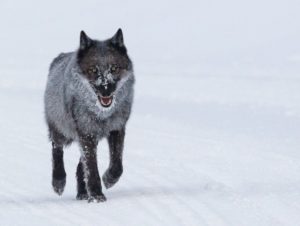Business coalition opposes wolf hunting, trapping near Yellowstone

A frosty wolf trots down a groomed trail in Yellowstone National Park in December. A coalition of Montana businesses surrounding the park have called for the Montana Fish and Wildlife Commission to reduce the hunting and trapping quota near Yellowstone.
Photo courtesy Jacob W. Frank, NPS
About 100 businesses have formed a coalition opposing Montana Fish, Wildlife & Parks’ higher wolf hunting and trapping quotas near Yellowstone National Park.
The Wild Livelihoods Business Coalition – comprised of business owners in the gateway communities of Gardiner, Livingston, West Yellowstone and Cooke City – has been pressing members of the Montana Fish and Wildlife Commission to revert to previous regulations in the hunting districts near the park’s northern boundary following the killing of 180 wolves across Montana this season.
Of these, 19 were killed in Wolf Management Units 313 and 316, located north of Yellowstone. Another 15 have been killed in WMU 310 on the northwest side of the park that also stretches into the Madison and Gallatin mountain ranges.
“These were some of the most viewable wolves in the lower 48, if not the world,” said Cara McGary, owner of In Our Nature Guiding Services, in the coalition’s press release. “In terms of drawing visitors, their value cannot be overstated.”
Hunters, trappers, outfitters and some legislators have argued wolf numbers in Montana are too high and their populations should be reduced to lessen depredation on species like elk and deer.
At last count, Yellowstone officials estimated the park’s wolf population at 123 wolves spread among nine packs. Wolves were reintroduced to the park beginning in 1995.
The Montana season for hunting and trapping wolves extends to March 15 but can be closed by the commissioners if they think the harvest is too high. The threshold for commission review for the entire Region 3 hunting district is 82 wolves killed. So far, 74 have been shot or trapped in the region.
Earlier this month, Yellowstone officials said 15 of the wolves killed in Montana were known to roam in the park, including the Phantom Lake pack which is now considered eliminated, the Associated Press reported.
“I know we’ve had many people watching Montana’s wolf hunting and trapping season this year,” said Montana Fish, Wildlife & Parks Director Hank Worsech in a Jan. 20 press release. “However, harvest numbers in the state are very similar to years past. We’ll continue to monitor these numbers closely as the hunting and trapping season continues.”
Facing similar criticism in 2014, a past commission decided to limit the killing of wolves in WMUs 313 and 316 to only three in recognition of their significance to Yellowstone-area businesses, which last year hosted a record 4.8 million visitors.
Also in 2014, the commission floated the idea of a “conservation stamp” to have nonhunters help pay for wildlife management. Hunters are now one of the main sources for funding FWP, which draws no state general fund dollars.
Back then, the commission also created a buffer zone around Glacier National Park to lessen the harvest of its wolves. This year, nine wolves have been killed from the two hunting districts closest to Glacier with another 27 taken from WMU 101, only a small portion of which borders the park’s western boundary.
The reduced harvests around the parks were changed last year after the Legislature passed a bill requiring Montana Fish, Wildlife & Parks to slash the state’s wolf population. The Commission then eliminated quotas and increased the number of wolves each hunter or trapper could kill to 10, or 20 per person if they chose to hunt and trap. The extended trapping season also allows snares.
“The state hasn’t responded to my pleas so far, except to remind me that when wolves leave Yellowstone they can be killed, but they seem to be missing the point,” said coalition member Nathan Varley. “The damage being done is to Montanans — our income, our livelihoods and ultimately our reputation as stewards of a world-renowned resource.”
Jeff Reed, who farms and runs a lodging business on the banks of the Yellowstone River north of the park, said the coalition isn’t interested in arguing whether wolves should revert to federal management for protection under the Endangered Species Act, as several conservation and wildlife groups have called for. Instead, his group is focused on the “out of proportion harvest” of wolves from such a small area.
“We’re not anti-hunting,” Reed said. “I hunt.”
Instead, he said the group is hoping to encourage the commission to consider “nonconsumptive use” as a management objective in places close to the park where wildlife have a demonstrated tourism value beyond hunting.
Wildlife tourism in the Gardiner area “dominates the business flow,” Reed said, as more than 1 million tourists visit the community over the course of the year to visit Yellowstone.
“So let’s broaden the conversation,” he added, noting that the wolf hunting and trapping season that has killed so many Yellowstone wolves is hurting Montana’s image nationally and internationally.
“The ask is very simple, revert back to the old quotas,” Reed said.
The group plans to take its request to the commissioners at their Feb. 4 meeting.


